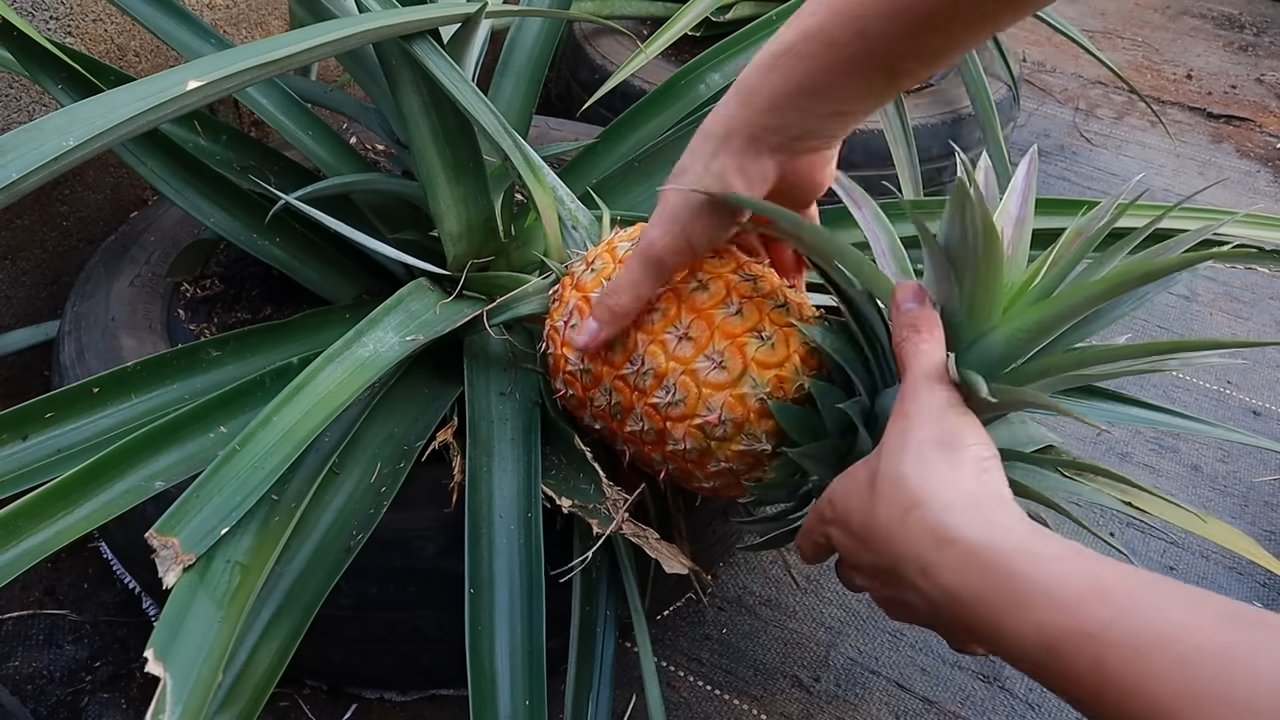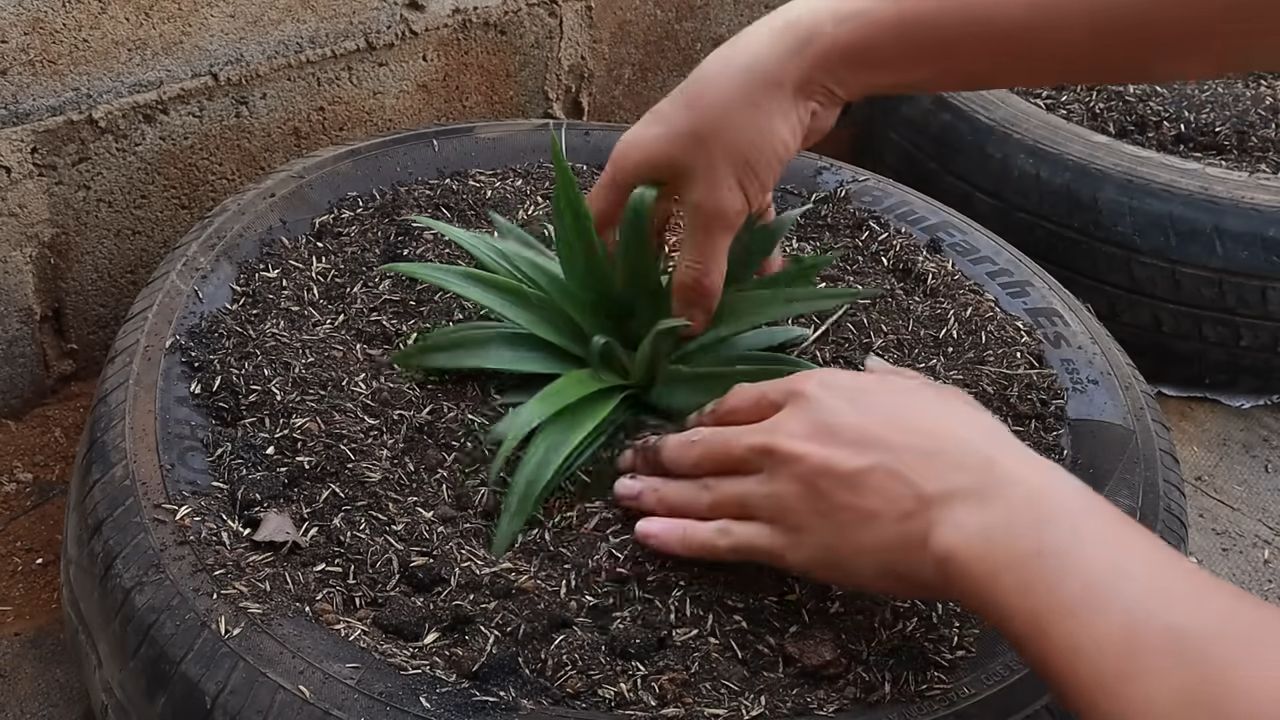Growing pineapples at home might sound like an exotic dream reserved for tropical climates, but I’m here to tell you it’s absolutely achievable, even if you’re miles away from Hawaii! Forget those expensive supermarket pineapples – imagine plucking a sweet, juicy, homegrown pineapple straight from your own garden or even your windowsill.
For centuries, the pineapple has been a symbol of hospitality and luxury. Originating in South America, it was quickly adopted by European royalty and became a prized possession, often displayed as a centerpiece at lavish feasts. Now, you can bring a touch of that regal history to your own home.
Why should you embark on this DIY adventure? Well, besides the sheer satisfaction of nurturing a plant from scrap to fruit, growing pineapples at home is a fantastic way to reduce your carbon footprint, enjoy pesticide-free produce, and add a unique, tropical flair to your living space. Plus, it’s a surprisingly easy and rewarding project that anyone can tackle. In this article, I’ll share my best tips and tricks to guide you through every step, from prepping the pineapple top to harvesting your very own golden delight. Get ready to transform your space into a mini-tropical paradise!

Growing Pineapples at Home: A Tropical Treat You Can DIY!
Okay, let’s be honest, who doesn’t love a juicy, sweet pineapple? And the thought of growing your own? Amazing! It might seem intimidating, but trust me, with a little patience and the right know-how, you can absolutely cultivate your own pineapple plant right at home. I’m going to walk you through everything you need to know, step-by-step, so you can enjoy the fruits (literally!) of your labor.
What You’ll Need: Your Pineapple Growing Arsenal
Before we dive in, let’s gather our supplies. This is a pretty straightforward project, so you probably have a lot of this stuff already.
* A Fresh Pineapple: This is the star of the show! Look for a ripe pineapple with healthy, green leaves. Avoid pineapples with brown, wilted, or damaged leaves. Organic is always a plus, but not essential.
* A Sharp Knife: A good, sharp knife is crucial for cleanly removing the top of the pineapple.
* Potting Soil: Use a well-draining potting mix. A mix designed for cacti or succulents works great, or you can amend regular potting soil with perlite or sand.
* A Pot: Choose a pot that’s at least 6-8 inches in diameter. It needs to have drainage holes!
* Watering Can or Hose: For, well, watering!
* Rooting Hormone (Optional): This can help speed up the rooting process, but it’s not absolutely necessary.
* Gloves (Optional): Pineapple leaves can be a bit prickly, so gloves can protect your hands.
* Spray Bottle (Optional): For misting the leaves.
Preparing the Pineapple Top: The Foundation of Your Future Fruit
This is where the magic begins! We’re going to carefully remove the top of the pineapple and prepare it for rooting.
1. Twist or Cut Off the Top: There are two ways to remove the top. You can either firmly grasp the leaves and twist the top off the pineapple. Or, using your sharp knife, carefully cut the top off, about an inch or two below the base of the leaves. I prefer cutting, as it gives a cleaner cut and reduces the risk of damaging the base.
2. Remove the Fruit Flesh: This is important! Carefully remove any remaining fruit flesh from the bottom of the pineapple top. This will prevent rotting, which can kill your chances of successful rooting. You can use your knife to gently scrape away the flesh.
3. Peel Back the Lower Leaves: Peel off the bottom few layers of leaves from the base of the pineapple top. This will expose the root nodes, which are the little bumps that will eventually sprout roots. Don’t be afraid to peel back a good inch or two of leaves.
4. Let it Dry: This is a crucial step! Allow the pineapple top to dry out for several days, or even up to a week. This helps to callous over the cut end, preventing rot. Place the pineapple top in a dry, well-ventilated area, away from direct sunlight. I usually put mine on a paper towel on my kitchen counter.
Rooting Your Pineapple Top: Patience is Key!
Now comes the waiting game. Rooting can take several weeks, so don’t get discouraged if you don’t see results immediately.
1. Water Rooting (Optional): You can root your pineapple top in water before planting it in soil. Place the pineapple top in a glass or jar of water, ensuring that only the base of the pineapple (where you peeled back the leaves) is submerged. Change the water every few days to prevent algae growth. Roots should start to appear in a few weeks.
2. Planting Directly in Soil: This is my preferred method. Fill your pot with well-draining potting mix. Make a hole in the center of the soil, large enough to accommodate the pineapple top.
3. Plant the Pineapple Top: Carefully place the pineapple top in the hole, ensuring that the base (where you peeled back the leaves) is buried in the soil. Gently pack the soil around the base of the pineapple top to secure it.
4. Water Thoroughly: Water the soil thoroughly until water drains out of the drainage holes.
5. Place in a Sunny Location: Pineapples love sunshine! Place your potted pineapple top in a warm, sunny location. A south-facing window is ideal.
6. Water Sparingly: Water only when the soil feels dry to the touch. Overwatering can lead to rot. I usually water mine about once a week, but this will depend on your climate and the humidity levels.
7. Be Patient: It can take several weeks, or even months, for roots to develop. You’ll know that roots have formed when you gently tug on the pineapple top and feel resistance.
Caring for Your Pineapple Plant: Nurturing Your Tropical Treasure
Once your pineapple plant has established roots, it’s time to provide it with the care it needs to thrive.
1. Sunlight: Pineapples need at least six hours of direct sunlight per day. If you don’t have a sunny window, you may need to supplement with a grow light.
2. Watering: Water your pineapple plant when the soil feels dry to the touch. Allow the soil to dry out slightly between waterings. Avoid overwatering, as this can lead to root rot.
3. Fertilizing: Feed your pineapple plant with a balanced liquid fertilizer every two to three months during the growing season (spring and summer). Follow the instructions on the fertilizer label.
4. Temperature: Pineapples thrive in warm temperatures, ideally between 65°F and 85°F (18°C and 29°C). Protect your plant from frost and cold temperatures.
5. Humidity: Pineapples appreciate humidity. You can increase humidity by misting the leaves regularly with a spray bottle, or by placing the pot on a tray filled with pebbles and water. Make sure the bottom of the pot isn’t sitting directly in the water.
6. Repotting: As your pineapple plant grows, you may need to repot it into a larger pot. Choose a pot that is a few inches larger in diameter than the current pot.
7. Pest Control: Keep an eye out for pests, such as mealybugs and spider mites. If you notice any pests, treat your plant with an insecticidal soap or neem oil.
Encouraging Fruiting: The Ultimate Goal!
This is the part everyone’s waiting for! Getting your pineapple plant to actually produce a pineapple can take a few years, but it’s totally worth the wait.
1. Maturity: Pineapple plants typically need to be at least two to three years old before they will produce fruit.
2. Ethephon Treatment (Optional): This is a common method used by commercial pineapple growers to induce flowering. However, ethephon is not readily available to home gardeners.
3. Apple Method (My Favorite!): This is a natural and effective way to encourage your pineapple plant to flower. Place a ripe apple, cut in half, upside down on top of the pineapple plant’s leaves, near the center. Cover the entire plant with a clear plastic bag to trap the ethylene gas released by the apple. Leave the apple in place for a week, then remove the bag and the apple. The ethylene gas will stimulate flowering.
4. Magnesium Sulfate (Epsom Salts): Some gardeners have success using Epsom salts to encourage flowering. Dissolve one tablespoon of Epsom salts in one gallon of water and water your pineapple plant with this solution. Repeat this every two to three months.
5. Patience, Patience, Patience: Even with these methods, it can still take several months for a flower to appear. Be patient and continue to provide your plant with the care it needs.
Harvesting Your Pineapple: The Sweet Reward
After the flower appears, it will take several months for the pineapple to develop.
1. Ripeness: A ripe pineapple will have a golden-yellow color and a sweet, fragrant aroma. The “eyes” of the pineapple should be relatively flat.
2. Harvesting: Using a sharp knife, carefully cut the pineapple from the plant.
3. Enjoy! Savor the delicious taste of your homegrown pineapple!
Growing pineapples at home is a rewarding experience. It takes time and patience, but the satisfaction of harvesting your own tropical fruit is well worth the effort. Good luck, and happy growing!

Conclusion
So, there you have it! Growing pineapples at home isn’t just a fun gardening project; it’s a rewarding experience that brings a touch of the tropics to your backyard or even your windowsill. Forget expensive grocery store pineapples – imagine the satisfaction of harvesting your own, bursting with flavor and sunshine. This DIY trick is a must-try for several compelling reasons.
First, it’s incredibly cost-effective. Instead of repeatedly purchasing pineapples, you’re essentially creating a self-sustaining system. The initial investment is minimal, and the return – a delicious, homegrown pineapple – is priceless. Second, you have complete control over the growing process. You can choose organic methods, ensuring your pineapple is free from harmful pesticides and chemicals. This is a significant advantage for health-conscious individuals and families. Third, and perhaps most importantly, it’s an incredibly engaging and educational activity. It’s a fantastic way to connect with nature, learn about plant life cycles, and even teach children about where their food comes from.
But the benefits don’t stop there. Homegrown pineapples often taste sweeter and more flavorful than store-bought varieties. This is because they’re allowed to ripen fully on the plant, developing their natural sugars and aromas to their peak potential. Plus, the sheer novelty of serving a pineapple you grew yourself is sure to impress your friends and family.
Don’t be afraid to experiment with variations! Try different pineapple varieties to see which one thrives best in your climate. Consider using different potting mixes to optimize drainage and nutrient availability. You can even explore hydroponic growing methods for a more controlled environment. For those in colder climates, consider using grow lights to supplement natural sunlight during the winter months. You can also experiment with different fertilizers to see which one promotes the best growth and fruit production. Remember to document your progress and adjust your techniques as needed.
We understand that growing pineapples at home can seem daunting at first, but with a little patience and care, you’ll be enjoying your own homegrown fruit in no time. The key is to provide the right conditions: plenty of sunlight, well-draining soil, and consistent moisture. Don’t be discouraged if your first attempt isn’t perfect. Gardening is a learning process, and every mistake is an opportunity to improve.
So, what are you waiting for? Grab a pineapple top, follow our simple steps, and embark on this exciting gardening adventure. We’re confident that you’ll be amazed by the results. We encourage you to try this DIY trick and share your experiences with us! Post pictures of your pineapple plants, share your tips and tricks, and let us know how your homegrown pineapples taste. We can’t wait to see your success stories! Let’s create a community of pineapple growers and spread the joy of homegrown goodness.
Frequently Asked Questions (FAQ)
How long does it take to grow a pineapple from a top?
Growing a pineapple from a top is a patience-testing process, but the reward is well worth the wait. Generally, it takes anywhere from 2 to 3 years for a pineapple plant grown from a top to produce its first fruit. The exact timeframe depends on several factors, including the climate, the amount of sunlight the plant receives, the quality of the soil, and the overall care provided. Warmer climates and ample sunlight will generally lead to faster growth. Remember that consistent watering and fertilization are also crucial for optimal development. Don’t be discouraged if it takes longer than expected; just keep providing the plant with the necessary care, and eventually, you’ll be rewarded with a delicious, homegrown pineapple.
What kind of soil is best for growing pineapples?
Pineapples thrive in well-draining, slightly acidic soil. A sandy loam soil is ideal, as it allows for good drainage while still retaining enough moisture. You can create your own potting mix by combining equal parts of potting soil, perlite, and sand. The perlite helps to improve drainage, while the sand adds weight and stability to the mix. Avoid using heavy clay soils, as they can become waterlogged and lead to root rot. If you’re planting your pineapple in a container, make sure the pot has drainage holes to prevent water from accumulating at the bottom. You can also amend your existing soil with organic matter, such as compost or peat moss, to improve its drainage and fertility.
How much sunlight do pineapples need?
Pineapples are sun-loving plants and require at least 6 hours of direct sunlight per day to thrive. If you’re growing your pineapple indoors, place it near a sunny window where it can receive ample sunlight. If you don’t have a sunny window, you can supplement with grow lights. During the summer months, you can move your pineapple plant outdoors to a sunny location. However, be sure to gradually acclimate it to the outdoor conditions to prevent sunburn. In colder climates, you may need to bring your pineapple plant indoors during the winter months to protect it from frost.
How often should I water my pineapple plant?
Water your pineapple plant regularly, but avoid overwatering. Allow the soil to dry out slightly between waterings. During the growing season (spring and summer), you may need to water more frequently than during the dormant season (fall and winter). A good rule of thumb is to water when the top inch of soil feels dry to the touch. When watering, water thoroughly until the water drains out of the drainage holes. Avoid getting water in the crown of the plant, as this can lead to rot.
What kind of fertilizer should I use for my pineapple plant?
Pineapples benefit from regular fertilization, especially during the growing season. Use a balanced fertilizer with a ratio of 10-10-10 or 14-14-14. You can also use a fertilizer specifically formulated for bromeliads, as pineapples are members of the bromeliad family. Fertilize your pineapple plant every 2-3 months during the growing season. Dilute the fertilizer according to the package instructions and apply it to the soil around the base of the plant. Avoid fertilizing during the dormant season.
How do I know when my pineapple is ripe?
Determining when a pineapple is ripe can be tricky, but there are several indicators to look for. First, the pineapple should have a strong, sweet aroma. Second, the color of the skin should change from green to yellow or golden-orange. Third, the eyes (the individual segments of the pineapple) should be slightly flattened. Fourth, the pineapple should feel heavy for its size. Finally, you can try gently pulling on one of the leaves. If it comes out easily, the pineapple is likely ripe. Once your pineapple is ripe, harvest it by cutting it off the plant with a sharp knife.
Can I grow a pineapple indoors?
Yes, you can absolutely grow a pineapple indoors, especially if you live in a colder climate. The key is to provide the plant with the right conditions: plenty of sunlight, well-draining soil, and consistent moisture. Place your pineapple plant near a sunny window or supplement with grow lights. Choose a pot that is large enough to accommodate the plant’s root system and make sure it has drainage holes. Water regularly, but avoid overwatering. With proper care, you can enjoy homegrown pineapples even if you don’t have a backyard.
What are some common problems when growing pineapples, and how can I fix them?
Some common problems when growing pineapples include root rot, mealybugs, and scale. Root rot is caused by overwatering and poor drainage. To prevent root rot, make sure your pineapple plant is planted in well-draining soil and avoid overwatering. Mealybugs and scale are common pests that can infest pineapple plants. To control these pests, you can use insecticidal soap or neem oil. Apply the insecticide according to the package instructions. You can also manually remove the pests with a cotton swab dipped in rubbing alcohol. Regularly inspect your pineapple plant for signs of pests and diseases to catch problems early.




Leave a Comment